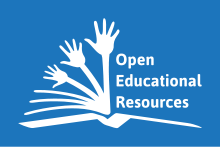Open means that free access is available to anyone.
Open Education Resources, commonly referred to as OER, are defined by UNESCO as:
"teaching, learning and research materials in any medium – digital or otherwise – that reside in the public domain or have been released under an open license that permits no-cost access, use, adaptation and redistribution by others with no or limited restrictions.
OER form part of ‘Open Solutions’, alongside Free and Open Source software (FOSS), Open Access (OA), Open Data (OD) and crowdsourcing platforms." [https://en.unesco.org/themes/building-knowledge-societies/oer]
The open education movement is based on the desire to make education widely accessible by providing free access to materials. Although there are multiple OER symbols in use, the UNESCO OER symbol is: 
Open Access, commonly referred to as OA, is defined by UNESCO as:
"free access to information and unrestricted use of electronic resources for everyone. Any kind of digital content can be OA, from texts and data to software, audio, video, and multi-media. While most of these are related to text only, a growing number are integrating text with images, data, and executable code. OA can also apply to non-scholarly content, like music, movies, and novels." [https://en.unesco.org/open-access/what-open-access]
The open access movement is based on the desire to promote and disseminate scholarly research, knowledge, and information as widely and quickly as possible by removing barriers to access. The symbol used to indicate Open Access is: